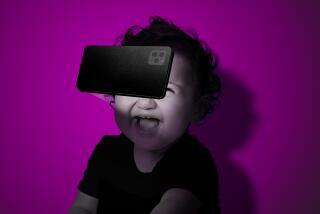Study Rates TV Ratings System a Success
- Share via
WASHINGTON — A majority of parents say they use the new TV ratings system to monitor their children’s viewing, but more than two-thirds say they won’t be rushing out to buy a new TV set equipped with technology that can automatically block objectionable shows.
Those are the major findings in the first comprehensive assessment of TV ratings since the controversial system was revised last fall at the start of the current television season.
The survey of 1,358 parents and 446 children ages 10 to 17, commissioned by the Henry J. Kaiser Family Foundation--a Menlo Park, Calif., group best known for its involvement in health care policy issues--found what analysts characterized as unusually widespread “awareness” of TV ratings. But the study also found consumer reluctance to pay for new technology that would automate monitoring TV shows.
“The conventional wisdom is that parents have greeted the ratings system with a yawn,” Vice President Al Gore said at a news conference to announce the survey’s results. “This is simply not true. . . . I read this survey as suggesting that [the ratings are] helping parents limit their children’s exposure to violence.”
Gore noted that the ratings are “beginning to make a difference,” with more than half of parents finding the system useful after less than a year in use.
Fifty-four percent of parents surveyed said they had used the ratings, while 46% said they had not, the study said.
The survey comes two months after the Federal Communications Commission formally gave its approval of the industry ratings plan.
The study was immediately seized upon by some conservative and parents groups for a reopening of the nationwide public debate about excessive sex and violence in the media that spawned the ratings system in the first place.
“What this really points to is that the ratings system and the V-chip is a band-aid solution to what the problem is in television,” said Mark Honig, executive director of the Los Angeles office of the Parents Television Council. “What parents are really upset about is the content of the programming.”
The survey contradicts some other recent polls that found parents were largely ignoring the new ratings system.
In a poll conducted in February by the Associated Press, for example, 7 in 10 adults said they paid little or no attention to the ratings. In a Los Angeles Times Poll conducted in September, 74% of respondents said they had never used ratings in deciding what to watch.
The current system, modeled after the 30-year-old movie ratings system, began in January 1997. It was adopted after parents, policymakers and the White House demanded that the entertainment industry take stronger measures to reduce sex and violence in the media. Initially, TV producers and syndicators gave shows age-based ratings that ranged from “TV-G” (appropriate for general audiences) to “TV-MA” (unsuitable for children under 17) and were aired by the major TV and cable networks.
The system expanded in October to include ratings for content. But one of the major networks, NBC, has refused to carry the S, V, L and D ratings (for sex, violence, language and suggestive dialogue), and cable channel Black Entertainment Television does not use ratings at all.
Shows that do have ratings display them during the first 15 seconds of a show in the upper left corner of the screen. For programs that are longer than one hour, the rating must be displayed again during the first 15 seconds of each hour of the show.
The TV ratings system is slated to be supplemented next year by the so-called V-chip, a device that can electronically intercept program ratings assigned to each show and block shows in certain categories selected by a user.
The V-chip technology, mandated by Congress in the landmark 1996 Telecommunications Act, must be included in half of all new television sets with 13-inch or larger screens by 1999; all new sets must have the technology by 2000.
Although the extra cost of V-chip-equipped sets will be nominal, consumers seem wary of paying for the technology, the study found.
More than 45% of parents polled said they were “not at all likely” in the next two years to buy either a new TV set or a set-top box equipped with the V-chip--electronic devices that would automatically block selected shows without daily intervention. And 24% said they were “not too likely” to make such purchases, according to the survey released today.
Still, 17% of the Kaiser study respondents said they were “somewhat likely” to buy a V-chip-equipped set, and 12% said they were “very likely” to do so. What’s more, 65% of parents polled said that if they had the technology they would use it to block some shows from their children’s view.
Rep. Edward J. Markey (D-Mass.), who is known as the father of the V-chip for shepherding through legislation that mandated the technology, said he believes the device is likely to quickly find a place in American living rooms.
“TV sets will continue to move into homes at the same pace they have historically--about 25 million sets a year,” Markey said. “If it’s true that one-third of the parents surveyed think it’s an important feature, I think we’ll see a marketplace skewing toward those manufacturers who include the V-chip.”
But some industry critics believe viewers may be becoming more jaded about a television business that former FCC Chairman Newton Minow once described as a “vast wasteland.”
“I think what we are finding is that parents are using TV ratings to some degree, but they don’t fully trust them,” said Bob Waliszewski, a manager at Focus on the Family, a Colorado Springs, Colo., group that has lobbied for a more content-based ratings system.
More to Read
Sign up for Essential California
The most important California stories and recommendations in your inbox every morning.
You may occasionally receive promotional content from the Los Angeles Times.













